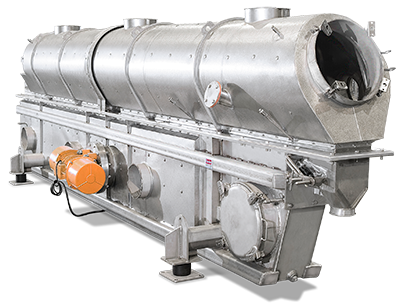
Posted on June 7th, 2024 by Carrier Vibrating
In industrial cooling, fluid bed coolers are a pivotal technology that enhances efficiency, preserves product quality, and curtails operational costs. Carrier Vibrating Equipment, a leader in this innovative field, offers an array of fluid bed cooler systems tailored to meet diverse industrial requirements.
Benefits of Using Fluid Bed Coolers
Available in both vibrating or static designs, fluid bed coolers offer several advantages over traditional cooling methods, enhancing various aspects of industrial processing:
- Enhanced Cooling Efficiency: The fluidized state ensures contact between individual particles and cooling air, facilitating rapid heat transfer.
- Uniform Product Quality: Continuous movement prevents agglomeration and ensures each particle is uniformly cooled.
- Reduced Energy Consumption: Optimizes airflow and temperature control, lowering operational costs.
- Versatility: Handle a wide range of particle sizes and types without damaging delicate materials.
- Scalability: Easily adjusts to different production volumes by altering airflow rates and temperatures.
These benefits collectively contribute to the superior performance and cost-efficiency of fluid bed coolers in various industrial applications.
Understanding Fluid Bed Coolers
A fluid bed cooler operates on the principle of fluidization, a process where materials are transformed into a fluid-like state by introducing a gas or air stream from below. As the air permeates through the perforated plate at the bottom of the cooler, it lifts and mixes the particles, creating a boiling action but with significantly cooler temperatures. This method facilitates rapid cooling and ensures uniform temperature distribution across all particles.
Key Components of Fluid Bed Coolers
Fluid bed coolers have several critical components that work together to ensure efficient operation. Here are the main parts:
- Perforated Distributor Plate: Serves as both support for the material and a means for air to pass uniformly.
- Cooling Chamber: Enclosed space where fluidization occurs.
- Air Handling Unit: Regulates airflow and temperature within the cooler.
- Exhaust System: Removes moisture-laden air from the system.
- Control System: Automates the cooling process, ensuring consistency and efficiency.
Each component plays a vital role in maintaining the cooler’s performance, contributing to the overall effectiveness of the fluidization process.
Operational Principles of Fluid Bed Coolers
To understand how fluid bed coolers achieve such high efficiency, it’s essential to look at their operational dynamics, which revolve around three main principles:
- Air Distribution: Evenly distributed air is crucial for maintaining a consistent fluidized state across all material particles. This uniform airflow prevents areas of unequal temperature and ensures efficient heat transfer.
- Temperature Control: Precisely controlled inlet air temperature ensures optimal cooling rates without thermal shock to sensitive products. This careful control helps maintain the integrity and quality of the processed materials.
- Moisture Control: Exhaust systems are tailored to remove enough moisture without over-drying or leaving residual dampness. This balance is critical for maintaining product quality, especially in hygroscopic materials.
These fundamental principles ensure the fluid bed cooler operates efficiently, providing consistent and reliable results in various industrial applications.
Installation Considerations
When integrating a fluid bed cooler into an industrial setup, several factors need consideration to ensure seamless operation and integration:
- Space Requirements: Adequate room around the equipment for maintenance activities is necessary to allow for easy access and routine inspections.
- Utility Connections: Proper connections for electrical power, compressed air, and exhaust systems must be established to ensure the cooler functions correctly and safely.
- Material Compatibility: Ensure that all parts in contact with process materials are made from compatible materials to avoid contamination. This is particularly important in industries where product purity is paramount.
Considering these installation considerations will help set up a fluid bed cooler that operates effectively within your specific industrial environment.
Maintenance Tips
To ensure longevity and optimal performance from your fluid bed cooler, adopting a proactive maintenance strategy is crucial:
- Regularly check and replace air filters to ensure clean and unrestricted airflow.
- Monitor all mechanical components for wear and lubricate regularly to prevent breakdowns and extend the life of moving parts.
- Keep the distributor plate clean to ensure unobstructed airflow. This component is vital for maintaining efficient operation as it directly affects air distribution through the cooled material.
By following these maintenance tips, you can maximize the efficiency of your fluid bed cooler and avoid costly downtime due to equipment failure.
Maximizing Industrial Efficiency with Fluid Bed Coolers
Fluid bed coolers represent an advanced solution in material processing by providing efficient cooling while maintaining product integrity. Carrier Vibrating Equipment continues to lead in this field with its diverse range of customizable options designed for specific industry needs. By choosing the right type of fluid bed cooler and adhering to proper maintenance practices, industries can greatly enhance their operational efficiency while reducing energy consumption significantly.






